| Listing 1 - 10 of 11 | << page >> |
Sort by
|
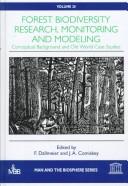
ISBN: 9231034081 1850709637 9781850709633 9789231034084 Year: 1998 Volume: 20 Publisher: Paris Unesco
Abstract | Keywords | Export | Availability | Bookmark
 Loading...
Loading...Choose an application
- Reference Manager
- EndNote
- RefWorks (Direct export to RefWorks)
Biological diversity --- Environmental monitoring --- Forest ecology --- Environnement --- Ecologie forestière --- Research --- Congresses --- Surveillance --- Congrès --- 574.472 --- 630*1 --- Biodiversity --- Environmental factors in forestry. Forest biology --- biodiversity --- forests --- modelling --- monitoring --- symposium proceedings --- 630*1 Environmental factors in forestry. Forest biology --- 574.472 Biodiversity --- Ecologie forestière --- Congresses. --- Congrès --- Forest biodiversity --- Diversity, Forest biological --- Forest biological diversity --- Forest diversity --- Monitoring
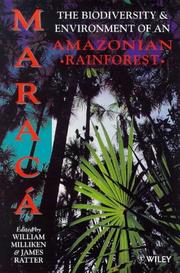
ISBN: 0471979171 Year: 1998 Publisher: Chichester John Wiley & Sons
Abstract | Keywords | Export | Availability | Bookmark
 Loading...
Loading...Choose an application
- Reference Manager
- EndNote
- RefWorks (Direct export to RefWorks)
AMS South America --- Amazon --- South America --- biodiversity --- rain forests --- RBINS-OTHER --- Forest biodiversity --- Natural history --- Rain forest ecology --- Equatorial forest ecology --- Rain forests --- Tropical rain forest ecology --- History, Natural --- Natural science --- Physiophilosophy --- Diversity, Forest biological --- Forest biological diversity --- Forest diversity --- Ecology --- Forest ecology --- Biology --- Science --- Biodiversity
Book
ISBN: 1283155583 9786613155580 0643098305 9780643098305 9781283155588 9780643096608 0643096604 0643100008 Year: 2009 Publisher: Collingwood, Vic. CSIRO Pub.
Abstract | Keywords | Export | Availability | Bookmark
 Loading...
Loading...Choose an application
- Reference Manager
- EndNote
- RefWorks (Direct export to RefWorks)
A major synthesis of 25 years of intensive research about the montane ash forests of Victoria.
Forest ecology --- Forest biodiversity --- Forest animals --- Forest conservation --- Eucalyptus regnans --- Ash, Mountain --- Australian oak --- Mountain ash --- Oak, Australian --- Oak, Tasmanian --- Stringy gum --- Swamp gum --- Tasmanian oak --- White mountain ash --- Eucalyptus --- Conservation of forests --- Forest preservation --- Forests and forestry --- Preservation of forests --- Nature conservation --- Deforestation --- Forest fauna --- Woodland animals --- Animals --- Diversity, Forest biological --- Forest biological diversity --- Forest diversity --- Biodiversity --- Forest ecosystems --- Ecology --- Conservation --- Control
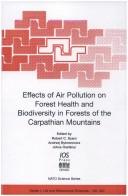
ISBN: 1586032585 4274905209 9781586032586 9784274905209 Year: 2002 Volume: v. 345 Publisher: Amsterdam : Tokyo : IOS Press Ohmsha,
Abstract | Keywords | Export | Availability | Bookmark
 Loading...
Loading...Choose an application
- Reference Manager
- EndNote
- RefWorks (Direct export to RefWorks)
Air --- Forest ecology --- Biodiversity --- Ecologie forestière --- Biodiversité --- Pollution --- Environmental aspects --- Congresses. --- Effect of air pollution on --- Congresses --- Aspect de l'environnement --- Congrès --- Effets de la pollution de l'air sur l' --- Effets de la pollution de l'air sur --- Ecologie forestière --- Biodiversité --- Congrès --- Forest biodiversity --- Forest health --- Health, Forest --- Ecosystem health --- Forests and forestry --- Plant health --- Diversity, Forest biological --- Forest biological diversity --- Forest diversity --- Pollution&delete& --- Environmental aspects&delete& --- Effect of air pollution on&delete& --- Biological diversification --- Biological diversity --- Biotic diversity --- Diversification, Biological --- Diversity, Biological --- Biology --- Biocomplexity --- Ecological heterogeneity --- Numbers of species --- Forest ecosystems --- Ecology --- Atmosphere
Book
ISBN: 9780521717038 9780521888738 9781139025843 9781139376785 1139376780 0521888735 9781139379649 113937964X 1139375350 9781139375351 0521717035 9781139375351 1139365673 1107226201 128066391X 9786613640840 113937821X 1139025848 1139371363 9781139365673 9781107226203 6613640840 9781139371360 Year: 2012 Publisher: Cambridge Cambridge University Press
Abstract | Keywords | Export | Availability | Bookmark
 Loading...
Loading...Choose an application
- Reference Manager
- EndNote
- RefWorks (Direct export to RefWorks)
Fossils document the existence of trees and wood-associated organisms from almost 400 million years ago, and today there are between 400,000 and 1 million wood-inhabiting species in the world. This is the first book to synthesise the natural history and conservation needs of wood-inhabiting organisms. Presenting a thorough introduction to biodiversity in decaying wood, the book studies the rich diversity of fungi, insects and vertebrates that depend upon dead wood. It describes the functional diversity of these organisms and their specific habitat requirements in terms of host trees, decay phases, tree dimensions, microhabitats and the surrounding environment. Recognising the threats posed by timber extraction and forest management, the authors also present management options for protecting and maintaining the diversity of these species in forests as well as in agricultural landscapes and urban parks.
Forest biodiversity --- Forest litter --- Wood --- Forest ecology --- Wood-decaying fungi --- Saproxylic insects --- Bois --- Ecologie forestière --- Biodegradation --- Deterioration --- Détérioration --- Forest biodiversity. --- Forest ecology. --- Wood-decaying fungi. --- Saproxylic insects. --- Biodegradation. --- Deterioration. --- Science --- Life Sciences --- Ecology. --- Ecologie forestière --- Détérioration --- Decay fungi, Wood --- Wood decay fungi --- Wood-destroying fungi --- Wood fungi --- Wood-rotting fungi --- Fungi --- Trees --- Deterioration of wood --- Wood decay --- Wood deterioration --- Wood borers --- Wood-living insects --- Insects --- Forest ecosystems --- Forests and forestry --- Ecology --- Diversity, Forest biological --- Forest biological diversity --- Forest diversity --- Biodiversity --- Diseases and pests --- Microbiology --- Decay --- Preservation
Book
ISBN: 940070481X 9786613081353 9400704828 1283081350 Year: 2011 Publisher: Dordrecht [Netherlands] : Springer,
Abstract | Keywords | Export | Availability | Bookmark
 Loading...
Loading...Choose an application
- Reference Manager
- EndNote
- RefWorks (Direct export to RefWorks)
Forest biodiversity is crucial to the ecological, economic, and social well-being of earth’s civilisations. Unfortunately, however, forest biodiversity is threatened to a serious degree in nearly all countries. Therefore, many countries have agreed to be parties to international agreements focused on maintaining, restoring, and monitoring biodiversity; further, these countries have agreed to report to international bodies on forest biodiversity status and trends. NFIs are the primary source of large-scale information available for this purpose, but the large variety of definitions, protocols, sampling designs, and plot configurations used by NFIs makes comparable international reporting extremely difficult. This book presents the results of Working Group 3 of COST Action E43 in the development of harmonization techniques for common reporting of estimates of forest biodiversity indicators using NFI data. Harmonization tests were carried out on a large common data base containing raw NFI data from 13 European countries and the USA. With its collection of practical examples for the estimation of forest biodiversity indicators, it’s a practical tool for anyone involved in forest inventories and in forest resource monitoring and management as well as for those involved in biodiversity assessment and reporting.
Forest biodiversity -- Monitoring. --- Forest management. --- Forest surveys. --- Earth & Environmental Sciences --- Forestry --- Forest biodiversity. --- Forest policy. --- Forest management --- Forest resource policy --- Forests and forestry --- State and forestry --- Diversity, Forest biological --- Forest biological diversity --- Forest diversity --- Government policy --- Life sciences. --- Biodiversity. --- Forestry. --- Life Sciences. --- Environmental Monitoring/Analysis. --- Forests and forestry. --- Monitoring/Environmental Analysis. --- Biological diversification --- Biological diversity --- Biotic diversity --- Diversification, Biological --- Diversity, Biological --- Biology --- Biocomplexity --- Ecological heterogeneity --- Numbers of species --- Forest land --- Forest lands --- Forest planting --- Forest production --- Forest sciences --- Forestation --- Forested lands --- Forestland --- Forestlands --- Forestry industry --- Forestry sciences --- Land, Forest --- Lands, Forest --- Silviculture --- Sylviculture --- Woodlands --- Woods (Forests) --- Agriculture --- Natural resources --- Afforestation --- Arboriculture --- Logging --- Timber --- Tree crops --- Trees --- Environmental monitoring. --- Biomonitoring (Ecology) --- Ecological monitoring --- Environmental quality --- Monitoring, Environmental --- Applied ecology --- Environmental engineering --- Pollution --- Measurement --- Monitoring
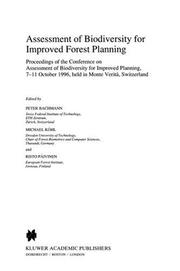
ISBN: 0792348729 9048149622 9401590060 Year: 1998 Publisher: Dordrecht : Kluwer academic,
Abstract | Keywords | Export | Availability | Bookmark
 Loading...
Loading...Choose an application
- Reference Manager
- EndNote
- RefWorks (Direct export to RefWorks)
The `Global Biodiversity Strategy' signed in 1992 in Rio de Janeiro, and the resolutions at the Ministerial Conferences on the Protection of Forests in Europe in Strasbourg, 1990, and Helsinki, 1993, commit the signatory states to monitor nationally the state of biodiversity and to sustain the characteristic natural variation in the country. Sustainability and long-term planning are the two terms best describing the philosophy of traditional forest management practices. However, the traditional planning techniques are not primarily developed to maintain sustainability of biodiversity. The gap between the international commitments and the practices in forest assessment and management is obvious. This publication presents experience in methodology for assessing and monitoring the variation of ecosystems and habitats in relation to biodiversity conservation and for integrating biodiversity in regional planning of forest management and land use. The state of the art in the field of natural resource assessments with special reference to forest biodiversity is reviewed, progress in integrating data on biodiversity in forest management planning is presented and the information needs regarding biodiversity conservation and the question to what degree assessment methods for forest biodiversity can be simplified for practical applications are discussed. The book is intended for researchers and practitioners in the field of forest and environmental planning and environmental policies.
Forest biodiversity --- Forest management --- Environmental Sciences and Forestry. Nature Management --- Planning --- Biodiversity --- CON Bioconservation --- biodiversity --- environmental management --- forestry --- nature conservation --- Biodiversity. --- Forestry. --- Environmental management. --- Forestry management. --- Environment. --- Environmental Management. --- Forestry Management. --- Environment, general. --- Forest administration --- Forest plants --- Forest resource administration --- Forest resource management --- Forest stewardship --- Forest vegetation management --- Forestry management --- Forests and forestry --- Stewardship, Forest --- Vegetation management, Forest --- Ecosystem management --- Natural resources --- Environmental stewardship --- Stewardship, Environmental --- Environmental sciences --- Management --- Forest land --- Forest lands --- Forest planting --- Forest production --- Forest sciences --- Forestation --- Forested lands --- Forestland --- Forestlands --- Forestry --- Forestry industry --- Forestry sciences --- Land, Forest --- Lands, Forest --- Silviculture --- Sylviculture --- Woodlands --- Woods (Forests) --- Agriculture --- Afforestation --- Arboriculture --- Logging --- Timber --- Tree crops --- Trees --- Administration --- Control --- Diversity, Forest biological --- Forest biological diversity --- Forest diversity
Book
ISBN: 3038977314 3038977306 Year: 2019 Publisher: MDPI - Multidisciplinary Digital Publishing Institute
Abstract | Keywords | Export | Availability | Bookmark
 Loading...
Loading...Choose an application
- Reference Manager
- EndNote
- RefWorks (Direct export to RefWorks)
Hardwood-dominated temperate forests (mostly in Eastern North America, Europe, North East Asia) provide valuable renewable timber and numerous ecosystem services. Many of these forests have been subjected to harvesting or conversion to agriculture, sometimes over centuries, that have greatly reduced their former extent and diversity. Natural regeneration following harvesting or during post-agricultural succession has often failed to restore these forests adequately. Past harvesting practices and the valuable timber of some species have led to a reduction in their abundance. The loss of apex predators has caused herbivore populations to increase and exert intense browsing pressure on hardwood regeneration, often preventing it. Particularly important are fruit, nut and acorn bearing species, because of their vital role in forest food webs and biodiversity. Restoring hardwood species to natural forests in which they were formerly more abundant will require a number of forest management actions (e.g., resistant hybrids, deer exclosures/protectors, enrichment planting, underplanting, etc.). Similarly, reforesting areas that were once natural forests will also require new silvicultural knowledge. Global warming trends will intensify the need for interventions to maintain the diversity and function of temperate hardwood forests, as well as for increase hardwood reforestation.
Fagaceae species --- soil disturbance --- non-timber forest products --- precision restoration --- protected landscape area --- tree selection --- cultural diversity --- Quercus rubra --- hardwood restoration --- enrichment planting --- sub-tropical hardwoods --- agroforestry --- herbicide effects --- biological diversity --- competition --- Juglans nigra L. --- understorey --- invasive plants --- wildfire --- forest restoration --- Quercus macrocarpa --- riparian forest restoration --- vegetation management --- assisted migration --- sugar maple --- deer browsing --- species composition --- tolerance --- phosphorus --- growth efficiency index --- floristic quality index --- shelterwood --- Carya cordiformis (Wangenh.) K. Koch --- monitoring --- indicators --- seed predation --- Bioclimatic niche --- non-parametric correlation --- unmanaged forest --- Native Americans --- abandoned agricultural field --- native mixed forests --- tree vigor --- forest diversity --- predation --- weed control --- nitrate --- facilitation --- inventory --- hardwoods --- Mexican tree species --- yellow birch --- tree plantation --- seedling establishment --- deer abundance --- avian guilds --- Pinus strobus L. --- Central Hardwood Forest region --- Pinus strobus --- Durango --- MaxEnt --- Juglans nigra --- oak regeneration --- forest regeneration --- Quercus rubra L. --- deer herbivory --- ecosystem services --- tree shelter
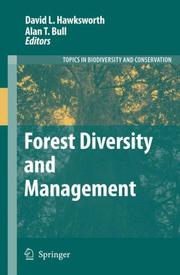
ISBN: 1280817186 9786610817184 1402052081 1402052073 9048173108 Year: 2006 Volume: v. 2 Publisher: Dordrecht, The Netherlands : Springer,
Abstract | Keywords | Export | Availability | Bookmark
 Loading...
Loading...Choose an application
- Reference Manager
- EndNote
- RefWorks (Direct export to RefWorks)
Natural forests with thousands of years of ecological continuity are unrivalled as the treasure store of terrestrial biodiversity on Earth. And while there is currently no fully comprehensive inventory of the biota associated with any given forest, it is reasonable to assume that in conserving natural forests we can conserve the myriads of unnamed bacteria, fungi, insects, mites and nematodes that forests support. Drawing on diverse research from biodiversity experts around the world, this collection of papers reflects the diversity of forest types and forest issues that concern forest scientists globally. Forest types considered vary from savannah and tropical rainforests to the ancient oak forests of Poland; issues explored include the effects of logging, management practices, forest dynamics and climate change on forest structure and biodiversity. Given the range of topics covered, this book should be of particular interest to those involved in teaching forest conservation and management, as well as to researchers requiring an overview of current work in forest diversity, conservation and sustainable management. Reprinted from Biodiversity and Conservation 15:4 (2006). .
Biodiversity conservation. --- Forest biodiversity. --- Forest conservation. --- Forest management. --- Diversity, Forest biological --- Forest biological diversity --- Forest diversity --- Biodiversity --- Biological diversity conservation --- Conservation of biodiversity --- Diversity conservation, Biological --- Gender mainstreaming in biodiversity conservation --- Maintenance of biological diversity --- Preservation of biological diversity --- Conservation of natural resources --- Ecosystem management --- Forest administration --- Forest plants --- Forest resource administration --- Forest resource management --- Forest stewardship --- Forest vegetation management --- Forestry management --- Forests and forestry --- Stewardship, Forest --- Vegetation management, Forest --- Natural resources --- Conservation of forests --- Forest preservation --- Preservation of forests --- Nature conservation --- Deforestation --- Conservation --- Management --- Administration --- Control --- Biodiversity. --- Forests and forestry. --- Plant Ecology. --- Endangered ecosystems. --- Landscape ecology. --- Forestry. --- Ecosystems. --- Landscape Ecology. --- Ecology --- Threatened ecosystems --- Biotic communities --- Botany --- Plants --- Forest land --- Forest lands --- Forest planting --- Forest production --- Forest sciences --- Forestation --- Forested lands --- Forestland --- Forestlands --- Forestry --- Forestry industry --- Forestry sciences --- Land, Forest --- Lands, Forest --- Silviculture --- Sylviculture --- Woodlands --- Woods (Forests) --- Agriculture --- Afforestation --- Arboriculture --- Logging --- Timber --- Tree crops --- Trees --- Biological diversification --- Biological diversity --- Biotic diversity --- Diversification, Biological --- Diversity, Biological --- Biology --- Biocomplexity --- Ecological heterogeneity --- Numbers of species --- Phytoecology --- Vegetation ecology --- Plant ecology. --- Biocenoses --- Biocoenoses --- Biogeoecology --- Biological communities --- Biomes --- Biotic community ecology --- Communities, Biotic --- Community ecology, Biotic --- Ecological communities --- Ecosystems --- Natural communities --- Population biology --- Floristic ecology
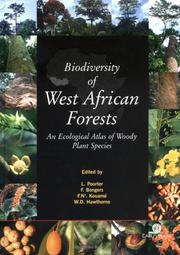
ISBN: 0851997341 Year: 2004 Publisher: Wallingford CABI
Abstract | Keywords | Export | Availability | Bookmark
 Loading...
Loading...Choose an application
- Reference Manager
- EndNote
- RefWorks (Direct export to RefWorks)
Forest plants --- Plant diversity --- Forest biodiversity --- Plant diversity conservation --- Forest conservation --- Flore forestière --- Diversité végétale --- Biodiversité forestière --- Forêts --- Conservation --- AFW West Africa --- tropical forests --- biodiversity --- trees --- woody plants --- ecology --- distribution maps --- 574.472 --- 581.526.422 --- 635.055 --- 630*18 --- 581.9 <66> --- Biodiversity --- Rain forest formations --- Trees (woody plants with trunks) --- Plant ecology --- Geographic botany. Plant geography (phytogeography). Floras. Geographic distribution of plants--Westafrikaanse Staten en Gebieden. West-Afrika --- 630*18 Plant ecology --- 635.055 Trees (woody plants with trunks) --- 581.526.422 Rain forest formations --- 574.472 Biodiversity --- 581.9 <66> Geographic botany. Plant geography (phytogeography). Floras. Geographic distribution of plants--Westafrikaanse Staten en Gebieden. West-Afrika --- Flore forestière --- Diversité végétale --- Biodiversité forestière --- Forêts --- Botanical diversity --- Diversity, Plant --- Floristic diversity --- Plant biodiversity --- Plant biological diversity --- Conservation of plant diversity --- Biodiversity conservation --- Plant conservation --- Forest botany --- Forest flora --- Forest vegetation --- Forest wildlife plants --- Forest-zone plants --- Wildlife plants, Forest --- Woodland plants --- Woodland vegetation --- Forests and forestry --- Plants --- Woodland garden plants --- Conservation of forests --- Forest preservation --- Preservation of forests --- Nature conservation --- Deforestation --- Diversity, Forest biological --- Forest biological diversity --- Forest diversity --- Control
| Listing 1 - 10 of 11 | << page >> |
Sort by
|

 Search
Search Feedback
Feedback About UniCat
About UniCat  Help
Help News
News